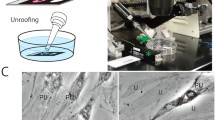Abstract
We have imaged microtubules, essential structural elements of the cytoskeleton in eukaryotic cells, in physiological conditions by scanning force microscopy. We have achieved molecular resolution without the use of cross-linking and chemical fixation methods. With tip forces below 0.3 nN, protofilaments with ~6 nm separation could be clearly distinguished. Lattice defects in the microtubule wall were directly visible, including point defects and protofilament separations. Higher tip forces destroyed the top half of the microtubules, revealing the inner surface of the substrate-attached protofilaments. Monomers could be resolved on these inner surfaces.





Similar content being viewed by others
Abbreviations
- APTS:
-
(3-aminopropyl)triethoxysilane
- DETA:
-
N 1-[3-(trimethoxysilyl)propyl]diethylenetriamine
- EM:
-
electron microscopy
- MT:
-
microtubule
- SFM:
-
scanning force microscopy
References
Alberts B, Johnson A, Lewis J, Raff M, Roberts K, Walter P (2002) Molecular biology of the cell, 4th edn. Garland, New York
Arnal I, Wade RH (1995) How does Taxol stabilize microtubules? Curr Biol 5:900–908
Binnig G, Quate CF, Gerber C (1986) Atomic force microscope. Phys Rev Lett 56:930–933
Cassimeris L, Spittle C (2001) Regulation of microtubule-associated proteins. Int Rev Cytol 210:163–226
Chretien D, Metoz F, Verde F, Karsenti E, Wade RH (1992) Lattice defects in microtubules: protofilament numbers vary within individual microtubules. J Cell Biol 117:1031–1040
Davis LJ, Odde DJ, Block SM, Gross SP (2002) The importance of lattice defects in katanin-mediated microtubule severing in vitro. Biophys J 82:2916–2927
de Pablo PJ, Colchero J, Gomez-Herrero J, Baro AM (1998) Jumping mode scanning force microscopy. Appl Phys Lett 73:3300–3302
de Pablo PJ, Schaap IAT, MacKintosh FC, Schmidt CF (2003a) Deformation and collapse of microtubules on the nanometer scale. Phys Rev Lett 91:098101
de Pablo PJ, Schaap IAT, Schmidt CF (2003b) Observation of microtubules with scanning force microscopy in liquid. Nanotechnology 14:143–146
Fritz M, Radmacher M, Allersma MW, Cleveland JP, Stewart RJ, Hansma PK, Schmidt CF (1995) Imaging microtubules in buffer solution using tapping mode atomic force microscopy. Proc SPIE 2384:150–157
Gittes F, Schmidt CF (1998) Thermal noise limitations on micromechanical experiments. Eur Biophys J 27:75–81
Hirokawa N (1998) Kinesin and dynein superfamily proteins and the mechanism of organelle transport. Science 279:519–526
Kikkawa M, Ishikawa T, Nakata T, Wakabayashi T, Hirokawa N (1994) Direct visualization of the microtubule lattice seam both in vitro and in vivo. J Cell Biol 127:1965–1971
Kirschner MW, Honig LS, Williams RC (1975) Quantitative electron microscopy of microtubule assembly in vitro. J Mol Biol 99:263–276
Mandelkow EM, Schultheiss R, Rapp R, Muller M, Mandelkow E (1986) On the surface lattice of microtubules: helix starts, protofilament number, seam, and handedness. J Cell Biol 102:1067–1073
McNally FJ, Vale RD (1993) Identification of katanin, an ATPase that severs and disassembles stable microtubules. Cell 75:419–429
Nogales E, Wolf SG, Downing KH (1998) Structure of the alpha beta tubulin dimer by electron crystallography. Nature 391:199–203
Nogales E, Whittaker M, Milligan RA, Downing KH (1999) High-resolution model of the microtubule. Cell 96:79–88
Pierson GB, Burton PR, Himes RH (1978) Alterations in number of protofilaments in microtubules assembled in vitro. J Cell Biol 76:223–228
Simon JR, Salmon ED (1990) The structure of microtubule ends during the elongation and shortening phases of dynamic instability examined by negative-stain electron microscopy. J Cell Sci 96:571–582
Snyder JP, Nettles JH, Cornett B, Downing KH, Nogales E (2001) The binding conformation of Taxol in beta-tubulin: a model based on electron crystallographic density. Proc Natl Acad Sci USA 98:5312–5306
Tilney LG, Bryan J, Bush DJ, Fujiwara K, Mooseker MS, Murphy DB, Snyder DH (1973) Microtubules: evidence for 13 protofilaments. J Cell Biol 59:267–275
Turner DC, Chang C, Fang K, Brandow SL, Murphy DB (1995) Selective adhesion of functional microtubules to patterned silane surfaces. Biophys J 69:2782–2789
Villarrubia JS (1997) Algorithms for scanned probe microscope image simulation, surface reconstruction, and tip estimation. J Res Natl Inst Stand Technol 102:425–454
Vinckier A, Dumortier C, Engelborghs Y, Hellemans L (1996) Dynamical and mechanical study of immobilized microtubules with atomic force microscopy. J Vac Sci Technol B 14:1427–1431
Williams RC Jr, Lee JC (1982) Preparation of tubulin from brain. Methods Enzymol 85:376–385
Acknowledgements
We thank Ken Downing for sharing his 3D MT model, Per Bullough for help with image analysis, Fred MacKintosh for helpful discussions, Johanna van Nes and René Koops for help with exploratory experiments, and financial support of the Dutch Foundation for Fundamental Research of Matter (FOM) and ALW/FOM project no. 01FB28/2.
Author information
Authors and Affiliations
Corresponding author
Rights and permissions
About this article
Cite this article
Schaap, I.A.T., de Pablo, P.J. & Schmidt, C.F. Resolving the molecular structure of microtubules under physiological conditions with scanning force microscopy. Eur Biophys J 33, 462–467 (2004). https://doi.org/10.1007/s00249-003-0386-8
Received:
Revised:
Accepted:
Published:
Issue Date:
DOI: https://doi.org/10.1007/s00249-003-0386-8




